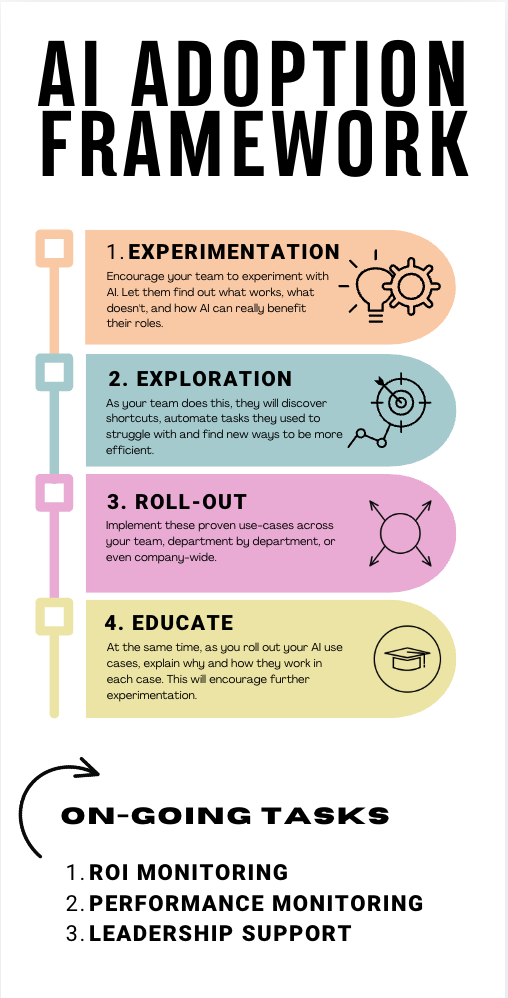The AI Adoption Framework for SMEs
Guiding SMEs Towards Successful AI Implementation
In the previous post, we analyzed why SMEs struggle with AI. Now we want to look at how SMEs can overcome these barriers. To do this, we will use a practical framework that I developed with one of my clients.
This framework focuses on a bottom-up approach, using employee initiative and organic exploration. This maximizes learning and practical application while minimizing upfront investment.
 Image by Author
Image by Author
1. Experimentation
Studies show that a large proportion of employees already use AI on a daily basis. Instead of resisting, embrace it! Encourage your team to experiment with AI tools in their daily work. Let them find out what works, what doesn't, and how AI can really benefit their roles. This hands-on experience will build internal AI literacy far more effectively than any formal training program ever could. They'll learn first-hand what AI can and can't do.
2. Exploration
As your team becomes more comfortable with AI, watch them get creative. They'll discover shortcuts, automate tasks they used to struggle with, and find new ways to be more efficient. Perhaps a marketer will streamline content creation, or an admin will handle routine requests on their own thanks to AI assistance. This organic exploration is where real, practical applications for AI in your business will emerge.
3. Roll-Out
Now that you've seen how AI is making a difference in specific roles, share these success stories! Implement these proven use cases across your team, department by department, or even company-wide. This scaled adoption turns isolated successes into tangible, enterprise-wide benefits.
4. Educate
At the same time, as you roll out your AI use cases, explain why and how they work in each case. Make these success stories transparent, so everyone understands the value and mechanics behind them. This transparency will build trust and encourage more employees to jump in and experiment. This will get the loop going.
In addition to these four core steps, there are three important ongoing tasks:
- ROI Monitoring: Measure the revenue increase or cost savings that AI brings against its cost. AI costs can balloon quickly, so stay vigilant.
- Performance Monitoring: Keep a close eye on the performance of your AI system after deployment. Is the performance stable or is it declining? Why? How does this affect your ROI calculation?
- Leadership Support: Finally, and most importantly, make sure you have leadership support. They need to champion AI at every stage, even when things fail. If employees are reluctant to experiment or discuss AI - both successes and failures - the whole initiative will stall. Leadership encouragement is the fuel that keeps this engine running.
Overcoming the Five Key Barriers with the AI Adoption Framework
1. Limited Budgets & High AI Costs:
Don't make a massive investment right away. Instead of diving headfirst into expensive enterprise solutions, start small and see what works. Let employees try open-source or low-cost tools that they can easily integrate into their work. This will help you identify real value propositions before you commit to big-ticket items. ROI monitoring becomes very important here - you need to track the real impact of these AI use cases to justify future investments in AI.
2. Lack of Knowledge & Expertise:
Let people get their hands dirty with AI tools and see how they work in practice. That's what experimentation and exploration does - it turns these theoretical concepts into real-world applications. Then, during the roll-out, show and explain to everyone the specific examples of how AI is being used in your business. This ensures that everyone understands why it works and helps build internal expertise that goes beyond theory.
3. Technological Challenges:
Start simple with Experiments. Use familiar AI tools first. It's less overwhelming for everyone. Then, once you've got a few wins under your belt, you can tackle bigger, more complex systems. Also, there's no need to bring in developers for every little integration! Tools like Zapier or Make.com are perfect for automating workflows and connecting different systems. Get them up and running before you commit to a big, expensive system integration. Don't do anything without a proven benefit and a positive ROI.
4. Internal Resistance & Organizational Barriers:
Transparency is key. Sharing those success stories - the "aha!" moments where AI makes things easier - shows everyone how valuable it is, not some scary new thing. And when leadership backs AI with their support, people are less afraid to try it. That's why education and roll-out are so important here - they show how AI works in our business, not just as an abstract concept. And when leadership champions AI, everyone feels more comfortable experimenting with it.
5. Complexity & Uncertainty in ROI Assessment:
Tackle the 'how much will this cost' question head on. Instead of guessing, start tracking real data from day one. Start with specific use cases that allow you to calculate the exact benefits and costs, making it clear how AI actually adds value. This will help you build confidence for larger investments because you can see tangible returns in smaller steps. It's slow - but the more wins you have, the more confident everyone becomes about the overall ROI and AI in general.
By following this framework, you can create a culture where everyone's excited to try new things, learn from their mistakes and constantly get better at using AI. It's not just about getting over these barriers - it's about building a foundation for long-term success so you can really differentiate yourself from the competition.
Are you interested in using AI in your business? I support entrepreneurs to adopt AI and build AI-based solutions. Just drop me a message and let's talk.